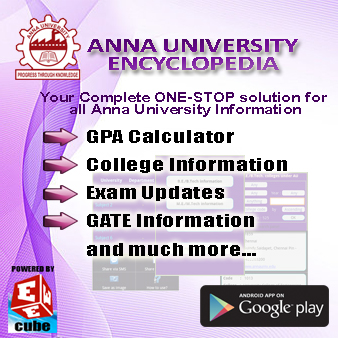SUBJECT RESOURCES:
CLICK HERE to access 'Question Banks'
CLICK HERE to access 'Previous Year Question Papers'
CLICK HERE to access 'Notes'
CLICK HERE to access '2 marks'
CLICK HERE to search more about this subject
SYLLABUS:
CLICK HERE to access 'Question Banks'
CLICK HERE to access 'Previous Year Question Papers'
CLICK HERE to access 'Notes'
CLICK HERE to access '2 marks'
CLICK HERE to search more about this subject
SYLLABUS:
EE2303 TRANSMISSION AND DISTRIBUTION L T P C
3 1 0 4
AIM
To understand the importance and the functioning of transmission and distribution of the electric power in an electrical utility (or) a power system.
OBJECTIVES
i. To develop expressions for the computation of transmission line parameters.
ii. To obtain the equivalent circuits for the transmission lines based on distance and operating
voltage for determining voltage regulation and efficiency. Also to improve the voltage profile of the transmission system.
iii. To analyses the voltage distribution in insulator strings and cables and methods to improve the same.
iv. To understand the operation of the different distribution schemes.
UNIT I INTRODUCTION 9
Structure of electric power system - different operating voltages of generation, transmission and distribution – advantage of higher operating voltage for AC transmission.
An introduction to EHV AC transmission, HVDC transmission and FACTs.
Mechanical design of transmission line between towers – sag and tension calculations using approximate equations taking into account the effect of ice and wind.
UNIT II TRANSMISSION LINE PARAMETERS 9
Parameters of resistance, inductance and capacitance calculations - single and three phase transmission lines - single and double circuits - solid, stranded and bundled conductors - symmetrical and unsymmetrical spacing – transposition of lines - concepts of GMR and GMD - skin and proximity effects - interference with neighbouring communication circuits.
Corona discharge characteristics – critical voltage and loss.
(Simple diagrams of typical towers and conductors for 400, 220 and 110 kV operations)
UNIT III MODELLING AND PERFORMANCE OF TRANSMISSION LINES 9
Transmission line classification - short line, medium line and long line - equivalent circuits – Ferranti effect - surge impedance, attenuation constant and phase constant - voltage regulation and transmission efficiency - real and reactive power flow in lines – power circle diagrams – shunt and series compensation.
An introduction to power angle diagram - surge-impedance loading, loadability limits based on
thermal loading; angle and voltage stability considerations.
UNIT IV INSULATORS AND CABLES 9
Classification of insulators for transmission and distribution purpose – voltage distribution in insulator string and grading - improvement of string efficiency.
Underground cables - constructional features of LT and HT cables – insulation resistance,
capacitance, dielectric stress and grading – tan δ and power loss - thermal characteristics.
UNIT V SUBSTATION, GROUNDING SYSTEM AND DISTRIBUTION SYSTEM 9
Classification, functions and major components of substations.
Bus-bar arrangements - substation bus schemes - single bus, double bus with double breaker,
double bus with single breaker, main and transfer bus, ring bus, breaker-and-a-half with two main buses, double bus-bar with bypass isolators. Importance of earthing in a substation. Qualitative treatment to neutral grounding and earthing practises in substations. Feeders, distributors and service mains. DC distributor – 2-wire and 3-wire, radial and ring main distribution. AC distribution – single phase and three phase 4-wire distribution.
L=45 T = 15 TOTAL = 60PERIODS
TEXT BOOKS
1. B.R.Gupta, ‘Power System Analysis and Design’, S. Chand, New Delhi, 2003.
2. S.N. Singh, ‘Electric Power Generation, Transmission and Distribution’, Prentice Hall of India Pvt.
Ltd, New Delhi, 2002.
REFERENCES
1. Luces M. Fualkenberry, Walter Coffer, ‘Electrical Power Distribution and Transmission’, Pearson
Education, 1996.
2. Hadi Saadat, ‘Power System Analysis,’ Tata McGraw Hill Publishing Company’, 2003.
3. Central Electricity Authority (CEA), ‘Guidelines for Transmission System Planning’, New Delhi.
4. ‘Tamil Nadu Electricity Board Handbook’, 2003.
|
|










No comments:
Post a Comment
Note: Only a member of this blog may post a comment.